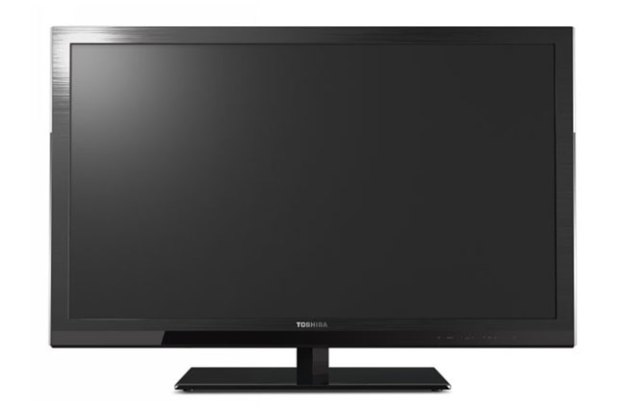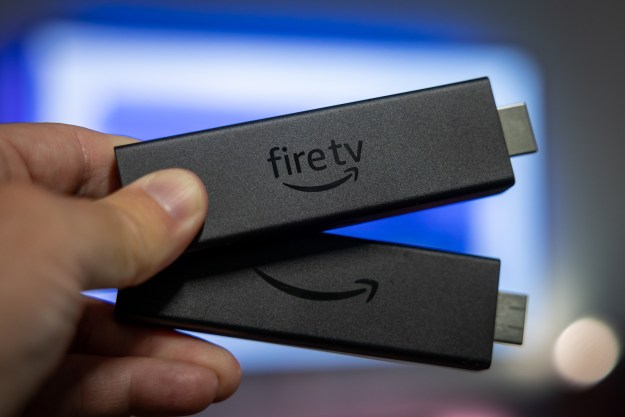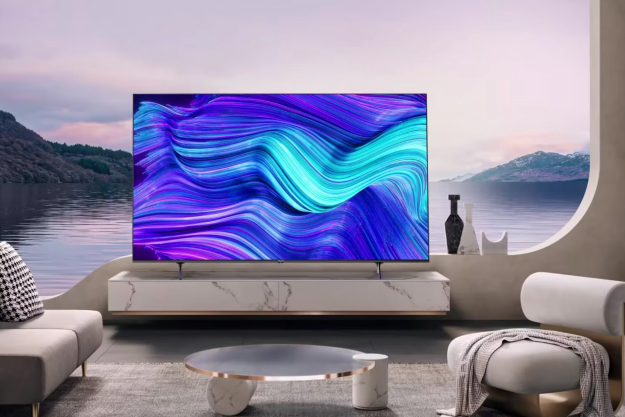
“The Toshiba 55TL515U provides a great picture and 3D in a cheap, user-friendly, super-slim package, with a nice, big screen.”
- Terrific, sharp picture
- Better than average black level, brightness
- Excellent color with adjustment
- Passive 3D with four pairs of glasses included
- Built-in Wi-Fi
- Back-lit remote
- Significant light bleeding around edges
- Poor onboard sound
- Finicky contrast
Toshiba TL515U series information: This review is based on our hands-on experience with the 55-inch 55TL515U TV. However, our observations also apply to the three other sizes in Toshiba’s TL515U series of LED TVs, including the 32-inch 32TL515U, 42-inch 42TL515U and 47-inch 47TL515U. According to Toshiba, the four sets have identical specifications (save dimensions and weight) and should offer similar performance.
| Models in Toshiba’s TL515U series | Size |
| Toshiba 32TL515U | 32 inches |
| Toshiba 42TL515U | 42 inches |
| Toshiba 47TL515U | 47 inches |
| Toshiba 55TL515U (reviewed) | 55 inches |
We’ve spent our fair share of time marveling at the progression of flat-panel televisions over the last year or so. Lucky for the consumer, as price points plummet, performance simultaneously soars. One might understandably think that, like the U.S. housing market, this high-value television bubble must eventually burst, but if the Toshiba 55TL515U is any kind of indicator, the trend will likely continue for a while.
The 55TL515U takes on the likes of the 55-inch LG LW5600 and the 55-inch Vizio XVT3SV, all similar in price, but with slight differences in engineering. The question is, does Toshiba’s decision to blend passive 3D technology, local dimming and edge-lit LED backlighting make the 55TL515U a strong competitor? We sat down with the 55-inch HDTV, got to know it a little better, and think we have the answer.
Out of the box
The 55TL515U display panel measures 51.22 inches across, 30.87 tall, a slender 1.14 deep, and just over 49 pounds. In the box with the panel we found a table stand, the usual bundle of manuals and assorted paperwork, three dongle cables (one for component video and two for A/V), one remote, some batteries and four pairs of passive 3D glasses.
Features and design
Even when powered down, the 55TL515U got plenty of oohs and aahs from visitors while set up in our testing room. While Toshiba didn’t outfit this model with an ultra-thin bezel (it measures about 1.5 inches at the top and sides and 2.25 inches at the bottom) the TV is certainly attractive. It’s depth of just over an inch is a big part of that, as is its anti-glare glass.
The back of the television is kept very clean. The TV’s inputs and outputs are arranged in a reversed L-shape pattern. Working our way from the top down, we found two USB inputs, three 1/8-inch jacks for the component and A/V dongles we mentioned, four HDMI inputs (three on the side, one at the bottom) a PC input with audio jack, an IR jack, one digital optical audio output, a LAN input and an antenna-cable jack.

The TV’s stand is made of blacked out glass. The half-diamond shaped column that rises from the stand is also glass and a nice break from the plastic cylinders we’re accustomed to seeing. Mounting the TV to its stand was a minor hassle, as the instructions suggest placing the panel on its face with a soft blanket or cloth to protect the panel’s surface. While the stand installation guide suggests in its pictures that the TV be elevated from the floor, they neglect to mention that tactic is totally necessary in the text. Toshiba recommends fully assembling the stand, then attaching the back of the TV, which requires about 8 inches of clearance from the floor to fit. Having assembled the stand a couple of different ways, we can confirm that following the manufacturer’s recommendations is key.
This 55-inch model from Toshiba is edge-lit with local dimming. That means that the LED lights are arranged around the edge of the television (as opposed to a full array lined up behind the LCD panel) and can be dimmed as necessary to help create deeper black levels and, reportedly, better contrast.
The 55TL515U is also a passive 3D TV, meaning no battery-powered glasses are necessary. The four pairs of polarized 3D glasses Toshiba includes are pretty rudimentary. They’re made of plastic, so at first they feel better than the el-cheapo paper jobs of yester-year, but they do not fit comfortably or securely. The lack of an adequate cutout for your nose left all our testers feeling like they would slide right off. They’ll get the job done on the short term, but for those who find themselves watching in 3D mode often (this set “converts” any 2D image into quasi-3D too) we suggest making an investment in a nicer pair of after-market passive 3D glasses. You and your friends will look a little less nerdy, too.

The 55TL515U is loaded up with a bunch of Toshiba’s proprietary sensors and processing. A light sensor on the front of the TV allows the set’s “AutoView” function to automatically adjust a bunch of picture parameters. “Dynalight,” as it turns out, is Toshiba’s cute name for local dimming and can be turned on or off as desired. Toshiba also outfits this set with “Clearscan 240,” a technology that backs up the set’s 120Hz refresh rate with a backlight scanning system that gives a 240hz refresh effect. Perhaps the most easily overlooked (but arguably useful) picture-related features are a “native” picture size setting, which defeats over-scanning and the image loss that comes from it. Toshiba also includes both advanced and expert picture setting sections that allow very fine adjustments to be made to the picture — a feature we found them especially useful when using a video calibration disc.
Of course, what’s a TV these days without built-in Wi-Fi and a whole bunch of Internet apps? This Toshiba has many, but not all of today’s favorites. Netflix, CinemaNow, Blockbuster, Vudu, YouTube, Pandora and Flickr all have apps, but Hulu Plus is absent…bummer.

DLNA certification? Yes. The set will play back MP2, MP4 and AVCHD files via network or USB. JPEG picture resolution maxes out at 4096 x 4096 pixels and 9MB file size. As for music, the 55TL515U can stream MP3, AAC and LPCM files with bitrates up to 320 kbps.
Calibration, testing and performance
To test the 55TL515U we connected a Sony 1700ES Blu-ray player, Xbox 360 and an HD antenna for some terrestrial HD reception. For video content we chose the 2D version of Avatar on Blu-Ray, the 2D and 3D version of Cloudy with a Chance of Meatballs and resurrected Transformers and The Matrix for some up-converted DVD action. We also spent some time streaming YouTube and Netflix videos, as well as video and music stored on a networked computer.
To calibrate the 55TL515U, we used the Spears & Munsil HD benchmark and calibration disc on Blu-ray. This disc has fast become our go-to for efficient calibration and testing of displays since it is easy to use and pretty comprehensive.
We first decided to test the set’s Autoview feature, which uses a sensor on the front of the display to gauge lighting conditions and make automatic adjustments to brightness and backlighting settings. The feature also reportedly makes on-the-fly adjustments to color and contrast based on the material it is displaying. Though the images that our calibration disc uses are usually static, we figured the Autoview adjustments ought to be in line with what are considered benchmark standards. Interestingly, when Autoview is turned on, only the contrast slider, “expert settings” and a couple of digital post-processing features are locked out. Brightness can still be adjusted, as can some rudimentary color, sharpness and tint settings.
We found that Autoview did a great job of adjusting brightness to suit ambient light conditions. The 55TL515U scored very well when it came to our Pluge low and high tests. Color temp was just slightly off, but to the naked eye, colors still looked fantastic to us. Ironically, contrast, one of the few settings that can’t be adjusted with Autoview engaged, is where the 55TL515U seemed to suffer the most. Again, the set looked great, but the tests on our calibration disc indicated that subtle details were being washed out. We were able to improve results slightly by jacking up the dynamic contrast setting to its maximum, though.
Over all, we thought that Autoview did a really solid job of maintaining picture accuracy and control. For those who want a simple, straightforward alternative to professional or self-calibration, Autoview does a pretty fancy trick. Unlike the set’s seriously overblown sports, game and PC modes, Autoview takes a more accurate approach, and we like it.
Generally, when calibrating a TV, the “movie” or “cinema” picture mode is a good launch pad. To be sure, this display’s movie modes are far better than the aforementioned ultra-bright, super-saturated alternatives. Still, after viewing the TV in “movie 1” mode for a while (movie 2 is a bit darker), we actually preferred the settings that were made with Autoview. For the sake of posterity, however, we went ahead and conducted our manual calibration.
In a dedicated, darkened theater room, we wound up setting the backlight at 50, the contrast at 47, the brightness at 6 and, the biggest adjustment of them all, the color at -21. Tint and sharpness were left alone. The significant color adjustment came as a pretty big surprise, since the colors appeared pretty accurate to our unaided eyes but removing the red and green outputs revealed that some pretty significant adjustments were needed to get things just right. This is where the “expert settings” section came in very handy. By being able to defeat the red and green output, we could skip the use of a hand-held filter and dial things in easily and accurately.
We then compared our calibration handy work with that of Autoview’s and decided, after some long-term watching, that our manual calibration was superior. It had a more balanced look with more satisfying contrast and black levels, which is what we were expecting from a TV with local dimming technology. Speaking of local dimming: let’s dig into that a little, shall we?
Having just reviewed the Sony XBR HX929, which we felt is the most outstanding example of the technology we’ve seen to date, it is difficult not to use that set as a reference. We did keep in mind that the Sony model costs over double what this Toshiba does and it features a full array of LED backlights, whereas the Toshiba is edge-lit. Still, considering that local dimming has historically been reserved for top-tier sets only, it is curious that Toshiba has managed to incorporate it into so budget-friendly a TV set. One tends to wonder if they may have developed some ground-breaking technology or simply scaled down the processing a bit to make it more affordable.

We had high hopes that the 55TL515U would avoid the uniformity issue that usually plagues edge-lit TVs, but it doesn’t entirely. While certainly better than some competing sets we’ve seen, the edges of this set are just slightly brighter than the middle. Frankly, that didn’t bother us much, it was the leakage we saw around the edges during really dark scenes that stood out. If an LED is active, you’ll know it. This tends to take away from the effectiveness of the local dimming feature as well.
On the plus side, the Toshiba seems to abate the “blooming” effect that is commonly associated with local dimming televisions, even besting the Sony XBR in that regard. So, once again, trade-offs come into play with this TV: You can have your super-thin TV with local dimming, but uniformity remains a problem.
3D viewing was on par with our previous experiences with passive 3D sets. We appreciated the absence of flicker associated with active 3D sets, and the 3D effect was entertaining. The 2D to 3D conversion, which is easily accessed by the remote control, seems an unnecessary feature. The conversion didn’t add any perceivable depth to the image. If anything, it only served to take away from the HD resolution of the movies we watched.
Quirks
On the whole, our experience with the 55TL515U was very positive. However, as is the case with most TVs, there were a few quirks that need mentioning. First, the TV takes a moment to power up once it is turned on or receives a signal from a source such as a receiver or Blu-ray disc player. Sound quality with this set is marginally better than what we experienced with Toshiba’s 46SL417U, but still pretty underwhelming. We found cycling through the set’s various picture modes (Autoview, Sports, Game etc…) took longer than we’d expect and usually involved the picture dropping out momentarily as the switch was made. Access to local network media continues to be slow, but that is not an issue specific to Toshiba or this model of TV. We have yet to find a TV that can pull up local network content quickly enough to make the feature worth offering. Finally, the remote (which we like otherwise) can be tough to read unless you view it straight on. Viewed at an angle, the numbers in the clear buttons became difficult to read.
On the other hand, there are some nice pluses to the 55TL515U. As we just mentioned, we like the remote a lot, which is well laid out, has buttons for all the really important features, and is well backlit. We also liked that the TV powers itself up when it senses a signal via HDMI and enjoyed the Netflix and YouTube interfaces, both of which provided good-quality images when viewing high-resolution content via a wired Internet connection.
Conclusion
The Toshiba 55TL515U provides a great picture and 3D in a cheap, user-friendly, super-slim package, with a nice, big screen. While this model doesn’t escape the issues often associated with edge-lit TVs, its local dimming feature does enable it to display slightly better black levels than sets with no local dimming at all. We appreciate some of Toshiba’s processing features, most notably the Autoview picture mode, which looks better than any of the set’s other presets. With a $1,500 street price, the 55TL515U gives its competition a good run for its money and represents an excellent value in large-screen, flat-panel televisions.
Highs:
- Terrific, sharp picture
- Better than average black level, brightness
- Excellent color with adjustment
- Passive 3D with four pairs of glasses included
- Built-in Wi-Fi
- Back-lit remote
Lows:
- Significant light bleeding around edges
- Poor onboard sound
- Finicky contrast




